L.A. Metro hosted a virtual meeting Wednesday to discuss the advancing K Line Northern Extension project, a major infrastructure initiative intended to enhance the county’s transit network.
“West Hollywood has a long track record of supporting the Fairfax-San Vicente hybrid route,” WeHo Mayor John M. Erickson said. “We are out there working extremely hard to make sure we not only fast-track this, but also ensure we’re doing all we can. West Hollywood needs Metro. We want Metro. We voted for Measure M overwhelmingly. This is a community train. It’s a train that will bring forth job centers and will not only connect our communities in new ways but also bring forth the future of our city and region. We are so happy this is moving forward.”
Since the initiation of the public scoping phase in spring 2021, the project has received roughly 1,450 comments. Public input is being actively gathered on the draft Environmental Impact Report (EIR), which will remain open for comments until September 5. Throughout the project’s lifecycle, from engineering design to construction and operation, Metro will continue to solicit community feedback and present updates to the Metro Board.
Supervisor Lindsay Horvath expressed her enthusiasm for the project during the latest public meeting. Horvath shared opening remarks emphasizing the transformative potential of the extension. She highlighted the importance of public engagement, noting that the input gathered at these hearings and beyond will shape the project’s development. Horvath reiterated that the K Line Northern Extension could become the most heavily utilized light rail line in the country upon completion, connecting a range of critical destinations including employment hubs, medical centers, arts districts and cultural landmarks.
Horvath reiterated that the K Line Northern Extension could become the most heavily utilized light rail line in the country upon completion, connecting a range of critical destinations including employment hubs, medical centers, arts districts and cultural landmarks.
Metro’s Project Manager Roger Martin provided an in-depth overview of the extension, which would expand the existing K Line northward from the Expo Line to the D (Purple) Line and eventually to the B (Red) Line in Hollywood.
This strategic expansion aims to close a significant gap in the regional transit network by connecting four existing rail lines and several of the busiest bus lines in Los Angeles County. The extension is also expected to serve major employment centers such as West Hollywood, Beverly Hills and Hollywood.
The project has secured $2.24 billion in Measure M funds, with the initial timeline suggesting construction would begin around 2047 and operations starting between 2049 and 2051. However, these estimates remain fluid, with potential acceleration or delays depending on funding availability, alignment choices and construction methods.
The draft EIR identifies multiple potential routes for the underground light rail extension, including three primary alignments:
- San Vicente-Fairfax (10 miles with nine stations)
- Fairfax (8 miles with seven stations)
- and La Brea (6 miles with six stations)
Each alignment includes an optional spur to the Hollywood Bowl, which could be added as a final phase if selected. Additionally, the project would necessitate the expansion of Metro’s existing Division 16 maintenance yard to accommodate the increased capacity.
By 2045, the extension is projected to generate between 47,000 and 60,000 daily trips, with low-income riders comprising 65% of the total. These projections underscore the line’s critical role in improving transit accessibility for underserved communities while enhancing regional mobility. The project would result in substantial travel time savings, benefitting not only residents and commuters in the immediate corridor but also riders throughout the county who use connecting services.
The extension’s construction is likely to occur in phases, similar to other major Metro rail projects such as the D Line extension. Depending on the alignment selected, the project could be divided into two or three segments, each taking eight to 12 years to complete.
For instance, the San Vicente-Fairfax alignment could require three phases, with the first linking the D Line, the second extending to Santa Monica Boulevard and the final phase reaching Hollywood. The optional spur to the Hollywood Bowl could be added in the last phase for any of the alignments.
The project will be fully underground, constructed using tunnel boring machines to create twin tunnels approximately 20 feet in diameter, positioned 40 to 100 feet below the surface. The design minimizes disruptions at ground level, although noise and vibration from train operations may still occur.
These effects will be mitigated through careful track design, tunnel depth and the surrounding geological conditions. Metro has extensive experience managing subway tunneling, as seen in existing lines such as the B (Red), D (Purple) and K (Crenshaw/LAX) lines.
Station design plans include one entrance per station, with provisions for future expansions. Station entrances could be integrated into plazas, existing buildings, or new developments. For instance, entrances might be incorporated into mixed-use developments or office buildings, providing convenient access for riders while enhancing local urban design. The stations themselves will feature knockout panels, allowing for additional entrances or station expansions in the future as ridership grows or as surrounding areas develop.
Preliminary cost estimates place the total project budget between $11 billion and $14.8 billion, accounting for construction costs, contingencies and potential cost escalations due to inflation and other factors.
These figures will be refined as the project advances through further design phases and as more detailed construction plans are developed. The current estimates are based on early-stage designs and include a 40% contingency due to the inherent uncertainties at this point in the planning process. As the design becomes more detailed and specific alignments are selected, cost estimates will become more precise.
Georgia Sheridan, Metro’s Project Director, presented key findings from the draft EIR, which assesses the project’s objectives, design and potential environmental impacts.
PUBLIC COMMENT
“I know there’s a lot of support for a West Hollywood connection, but the main reason no one uses Metro currently is because it’s so slow; it takes so long to get anywhere. So, I think we could benefit the entire city if we take the route that gets people places the fastest.” — Seth Harrington
The EIR is a requirement under CEQA, aimed at informing the public and decision-makers about any significant environmental impacts associated with the project. Sheridan explained that the draft EIR identifies several areas where mitigation measures would be required to reduce impacts to less than significant levels. However, some impacts, particularly during construction, remain significant and unavoidable. These include potential effects on paleontological resources and cultural heritage sites.
The draft EIR outlines three primary alignments for the extension: San Vicente-Fairfax, Fairfax and La Brea. Each alignment has been evaluated for its environmental impact, construction feasibility and community impact.
PUBLIC COMMENT
“There’s also documented evidence that some of the LA Metro has impacted and resulted in vibration in seismic issues that we need to explore, as well as any other issues that would disrupt or taint the character of these historic neighborhoods, which are vibrantly diverse and have a very strong African-American historical legacy that is rare to find in the city.”
— Ranita Smith
For instance, the San Vicente-Fairfax alignment would affect the Santa Palm Car Wash in West Hollywood, a historic site that could be impacted by construction staging or station development. In Hollywood, potential impacts include historic buildings near the Hollywood-Highland area, where the extension would connect to the existing B (Red) Line.
Mitigation strategies include preserving the architectural integrity of historic buildings and working with local stakeholders to maintain the cultural identity of affected neighborhoods. An example cited was the Westwood Medical Plaza, where Metro successfully integrated a new underground station while preserving the historic character of the Paul Williams-designed building. Similar approaches could be applied to mitigate impacts in areas like West Hollywood and Hollywood.
PUBLIC COMMENT
“I think there’s some unrealistic matters regarding the cost of the Metro, especially talking about 15 years down the line. I think that $12 billion for the most expensive one is going to balloon to more like $50 billion.”
— R. Forus
In addition to rail-based options, the draft EIR considers non-rail alternatives such as a high-frequency bus service along the La Brea corridor. Although this alternative presents fewer environmental impacts, it falls short in delivering the long-term benefits and capacity that rail offers. The draft also includes a “no project” alternative, which would result in significant long-term consequences, such as worsening air quality and missed opportunities for improved transit connectivity. These alternatives are required for evaluation under CEQA, ensuring that all potential options are considered.
The Fairfax alignment is identified as the proposed project due to its historical precedence, dating back to studies conducted in the 1980s. However, Metro officials stress that no decision has been made and all alignments are being considered equally. The final decision on a locally preferred alternative (LPA) will be made by the Metro Board later this year, following extensive community input and further analysis. The decision will factor in project objectives, environmental findings, costs, funding and public sentiment.
PUBLIC COMMENT
“These people that are worried about Metro and mitigations, there’s no vibration, that’s silly. It can all be done, and this is the first of many meetings for the next 10 years. This is just because you didn’t know about the meeting last week; stop whining, there’ll be many more meetings, like 10 years’ worth.”
— Art Reed, executive director, Transit Coalition
To support informed public participation, Metro has made extensive resources available, including summaries of outreach efforts, ridership reports and detailed descriptions of each alignment’s potential benefits and challenges. An interactive story map on Metro’s website allows the public to explore the project in detail, while printed copies of the draft EIR are available at local libraries. Community members can request additional information or printed materials through Metro’s website.
The current public comment period spans 45 days, ending on September 5. Three public hearings have been held so far: one at Dorsey High School on August 10, another at Pan Pacific Park and a virtual meeting conducted most recently. These hearings are recorded for those who cannot attend live, allowing for broader community engagement.
PUBLIC COMMENT:
“I’m one of the few residents that received a certified letter saying that the Metro may be tunneling directly underneath my home. I’m wondering how Metro is planning on considering the reduction in value just right off the bat. If I were to sell my home today, I’d have to disclose that there’s a potential rail coming underneath my home, and for all the homes in the area, just the threat of the Metro tunneling underneath your home, to push back on B, I don’t think it’s silly—it’s a perceived value in the marketplace. If someone has a choice to buy a home under Metro or not, I think the marketplace will speak for itself.”
— Ben Cornwell
As the project moves forward, Metro will continue to refine its plans based on community feedback and further technical analysis.
Once the Metro Board selects a locally preferred alternative, additional design work will commence, followed by final environmental clearance and project approval. Construction could begin within the next decade, depending on funding and alignment decisions. However, the project’s ultimate success depends on ongoing public engagement, collaboration with local stakeholders and careful consideration of both environmental and community impacts.
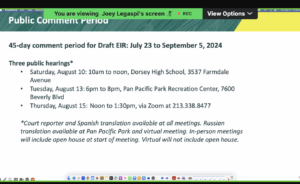
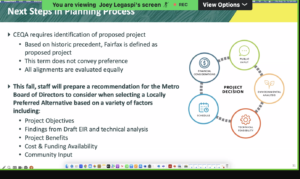
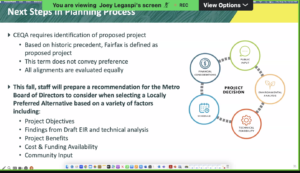
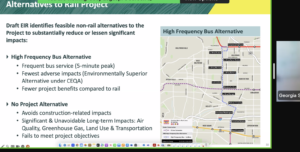
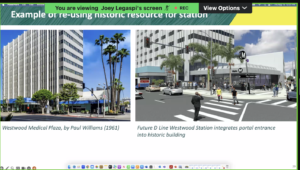
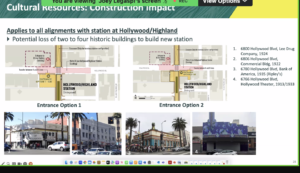
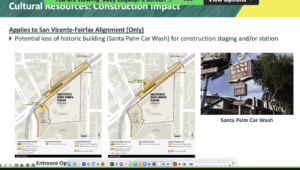
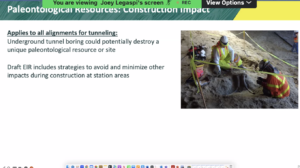
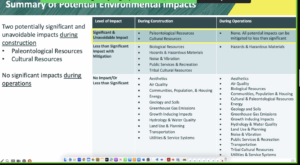
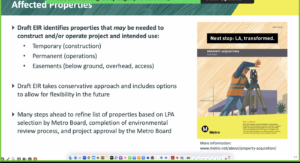
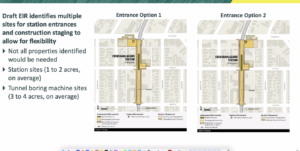
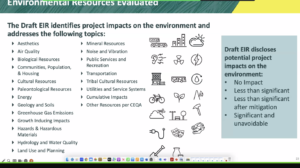
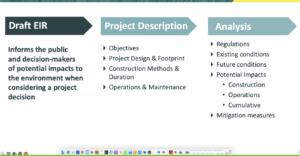
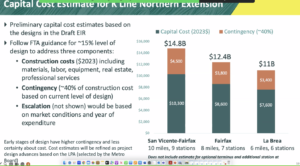
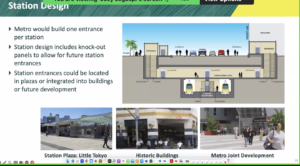
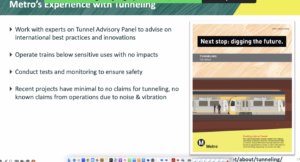
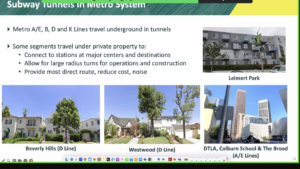
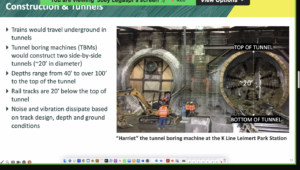
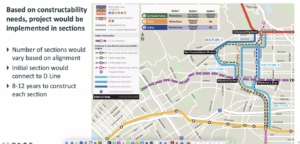
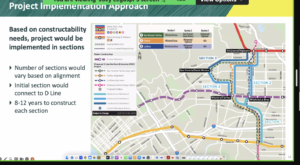
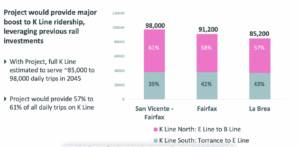
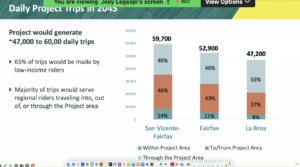
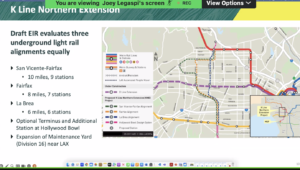
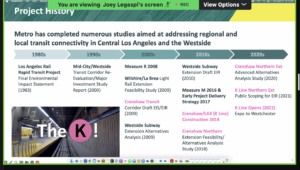
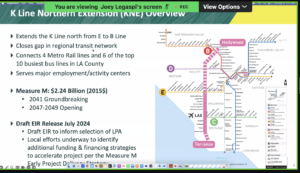

Agree. The only reason the WeHo ‘option’ is being pushed is because of the council and their PR machine. What a waste of money. If they increased the police force we would have a safer neighborhood. If Metro comes through every small business owner along SM Blvd will lose their businesses because it will be a decade of construction. The Draft EIR is pretty clear on the environmental damage being caused and ridership has decreased from a high of 9.8M in July of 2013 to 5.7M in July of this year when rail miles have more than doubled but people… Read more »
Ridership for Metro K line has INCREASED far exceeding pre-pandemic levels, from Crenshaw to LAX it’s been packed every time I needed to catch a flight✈. The Environmental impact of light rail vs. diesel busses is heavily in favor of light rail 🚈 . The West Hollywood Metro K Line Extension will drastically reduce the city’s dependence on automobiles & buses, making it potentially a car free city. This investment will pay off for West Hollywood for years to come ❗
This project should not go through West Hollywood or La Brea.
It is ridiculous. Extremely bad and disruptive to the neighborhood.
What was the rationale for changing the extremely easy-to-understand color nomenclature to letters?
Wish the Metro folks would update costs and include security in those costs. They should also update ridership which has fallen dramatically. No matter how many pr dollars weho spends, this project should not go through WeHo. It makes no sense. Go down La Brea directly and don’t adversely effect all the neighborhoods along San Vicente
Exactly, which is why the project will be kicked down the road for 20 years. I can’t imagine the chaos of moving the sheriffs HQ when the La Brea option makes most economic sense backed up with a good bus system (which we actually have).